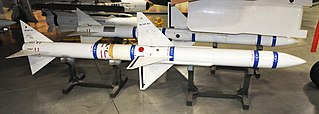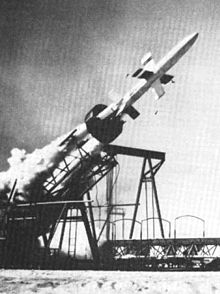
The AIM-7 Sparrow is an American medium-range semi-active radar homing air-to-air missile operated by the United States Air Force, United States Navy, United States Marine Corps, and various other air forces and navies. Sparrow and its derivatives were the West's principal beyond visual range (BVR) air-to-air missile from the late 1950s until the 1990s. It remains in service, although it is being phased out in aviation applications in favor of the more advanced AIM-120 AMRAAM.

In military terminology, a missile is a guided airborne ranged weapon capable of self-propelled flight usually by a jet engine or rocket motor. Missiles are thus also called guided missiles or guided rockets. Missiles have five system components: targeting, guidance system, flight system, engine, and warhead. Missiles come in types adapted for different purposes: surface-to-surface and air-to-surface missiles, surface-to-air missiles, air-to-air missiles, and anti-satellite weapons.

A surface-to-air missile (SAM), also known as a ground-to-air missile (GTAM) or surface-to-air guided weapon (SAGW), is a missile designed to be launched from the ground to destroy aircraft or other missiles. It is one type of anti-aircraft system; in modern armed forces, missiles have replaced most other forms of dedicated anti-aircraft weapons, with anti-aircraft guns pushed into specialized roles.

A glide bomb or stand-off bomb is a standoff weapon with flight control surfaces to give it a flatter, gliding flight path than that of a conventional bomb without such surfaces. This allows it to be released at a distance from the target rather than right over it, allowing a successful attack without exposing the launching aircraft to air defenses near the target. Glide bombs can accurately deliver warheads in a manner comparable to cruise missiles at a fraction of the cost—sometimes by installing flight control kits on simple unguided bombs—and they are very difficult for surface-to-air missiles to intercept due to their tiny radar signatures and short flight times. The only effective countermeasure is to intercept launching aircraft before they approach within range, making glide bombs very potent weapons where wartime exigencies prevent this.

The RIM-116 Rolling Airframe Missile (RAM) is a small, lightweight, infrared homing surface-to-air missile in use by the German, Japanese, Greek, Turkish, South Korean, Saudi Arabian, Egyptian, Mexican, UAE, and United States navies. It was originally intended and used primarily as a point-defense weapon against anti-ship missiles. As its name indicates, RAM rolls as it flies. The missile must roll during flight because the RF tracking system uses a two-antenna interferometer that can measure phase interference of the electromagnetic wave in one plane only. The rolling interferometer permits the antennas to look at all planes of incoming energy. In addition, because the missile rolls, only one pair of steering canards is required. As of 2005, it is the only U.S. Navy missile to operate in this manner.

The BAe Sea Eagle is a medium-weight sea-skimming anti-ship missile designed and built by BAe Dynamics. It is designed to sink or disable ships up to the size of aircraft carriers in the face of jamming and other countermeasures including decoys. Its users include the Royal Air Force and Royal Navy, the Royal Saudi Air Force, and the Indian Navy.

Bendix RIM-8 Talos was a long-range naval surface-to-air missile (SAM), among the earliest SAMs to equip United States Navy ships. The Talos used radar beam riding for guidance to the vicinity of its target, and semi-active radar homing (SARH) for terminal guidance. The four antennas surrounding the nose were SARH receivers, which functioned as a continuous wave interferometer. A solid rocket booster provided thrust for launch and a Bendix ramjet powered its flight to the target, with the warhead serving as the ramjet's compressor.

The ASM-N-2 Bat was a United States Navy World War II radar-guided glide bomb which was used in combat beginning in April 1944. It was developed and overseen by a unit within the National Bureau of Standards with assistance from the Navy's Bureau of Ordnance, the Massachusetts Institute of Technology, and Bell Telephone Laboratories. It is considered to be the first fully automated guided missile used in combat.

The Fairchild SM-73 was a planned sub-sonic, jet-powered, long-range, ground-launched decoy cruise missile. XSM-73 was the designation for the development version. Development began in 1952 with conceptual studies and ended when the program was canceled in 1958 after 15 test flights but before any operational deployment. The operational concept was to base squadrons of XM-73s at various locations in the United States and if necessary launch the aircraft as part of a strategic bomber attack. The aircraft would fly autonomously under inertial guidance towards the target area, using radar reflectors and electronic countermeasures to imitate American bombers and thus confuse and saturate enemy air defenses. The program was cancelled because the missile was not able to simulate a B-52 bomber on radar.

The AUM-N-2 Petrel, also known as Kingfisher C and AUM-2, was an air-to-surface missile produced as part of Project Kingfisher for the United States Navy. Intended to use against enemy surface ships and surfaced submarines giving aircraft the ability to deliver aerial torpedoes from outside the range of defensive armament, it saw brief operational service in the late 1950s. The project was never considered a high priority by the Navy however, as it was useless against submerged submarines, which were considered the greatest potential threat.

The four De Zeven Provinciën-class frigates are air-defence and command frigates in service with the Royal Netherlands Navy. This class of ships is also known as "LCF". The ships are similar to the German Sachsen-class frigates in role and mission.

Operation Bumblebee was a US Navy effort to develop surface-to-air missiles (SAMs) to provide a mid-range layer of anti-aircraft defense between anti-aircraft guns in the short range and fighter aircraft operating at long range. A major reason for the Bumblebee efforts was the need to engage bombers before they could launch standoff anti-shipping weapons, as these aircraft might never enter the range of the shipboard guns.

Project Kingfisher was a weapons-development program initiated by the United States Navy during the latter part of World War II. Intended to provide aircraft and surface ships with the ability to deliver torpedoes to targets from outside the range of defensive armament, six different missile concepts were developed; four were selected for full development programs, but only one reached operational service.

The GAM-63 RASCAL was a supersonic air-to-surface missile that was developed by the Bell Aircraft Company. The RASCAL was the United States Air Force's first nuclear armed standoff missile. The RASCAL was initially designated the ASM-A-2, then re-designated the B-63 in 1951 and finally re-designated the GAM-63 in 1955. The name RASCAL was the acronym for RAdar SCAnning Link, the missile's guidance system. The RASCAL project was cancelled in September 1958.

The RIM-174 Standard Extended Range Active Missile (ERAM), or Standard Missile 6 (SM-6), is a missile in current production for the United States Navy. It was designed for extended-range anti-air warfare (ER-AAW) purposes, providing capability against fixed and rotary-wing aircraft, unmanned aerial vehicles, anti-ship cruise missiles in flight, both over sea and land, and terminal ballistic missile defense. It can also be used as a high-speed anti-ship missile. The missile uses the airframe of the earlier SM-2ER Block IV (RIM-156A) missile, adding the active radar homing seeker from the AIM-120C AMRAAM in place of the semi-active seeker of the previous design. This will improve the capability of the Standard missile against highly agile targets and targets beyond the effective range of the launching vessels' target illumination radars. Initial operating capability was planned for 2013 and was achieved on 27 November 2013. The SM-6 is not meant to replace the SM-2 series of missiles but will serve alongside and provide extended range and increased firepower. It was approved for export in January 2017.

The General Dynamics Mauler was a self-propelled anti-aircraft missile system designed to a late 1950s US Army requirement for a system to combat low-flying high-performance tactical fighters and short-range ballistic missiles.

The AAM-N-5 Meteor was an early American air-to-air missile, developed by the Massachusetts Institute of Technology and Bell Aircraft for the United States Navy. Initially, both air-launched and ship-launched versions were considered. Versions designed for launch from carrier-based aircraft proceeded to the flight testing stage before the project was cancelled.

The PTV-N-2 Gorgon IV was a subsonic ramjet-powered missile developed by the Glenn L. Martin Company for the United States Navy. Originally intended as an air-to-surface weapon, it materialized as a propulsion test vehicle, and between 1947 and 1950 was used for test purposes and, as the KDM Plover, as a target drone.

The AAM-N-10 Eagle was a long-range air-to-air missile developed by the Bendix Corporation for use by the United States Navy. Intended for carriage by the Douglas F6D Missileer fleet defense fighter, the Eagle program was cancelled before testing could begin, but the lessons learned were used in the development of the AIM-54 Phoenix missile.

The Vertical Launch - Short Range Surface to Air Missile, or VL-SRSAM is a quick reaction surface-to-air missile developed by the Defence Research and Development Organisation (DRDO). During mid-course flight, the missile uses fibre-optic gyroscope based inertial guidance mechanism while in terminal phase uses active radar homing. With lock on before launch (LOBL) and lock on after launch (LOAL) capability, the missile receives mid-course update via datalink. VL-SRSAM intended to replace older Barak 1 surface to air missile system onboard Indian Navy warships. It will also be used as short range air defence system for Indian Air Force.






















